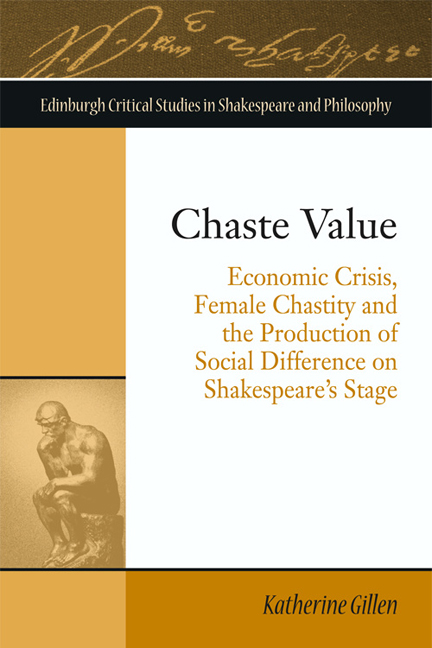 Chaste Value
Chaste Value Published online by Cambridge University Press: 22 December 2017
Picture Macbeth alone on stage, staring intently into empty space. ‘Is this a dagger which I see before me?’ he asks, grasping decisively at the air. On one hand, this is a quintessentially theatrical question. At once an object and a vector, the dagger describes the possibility of knowledge (‘Is this a dagger’) in specifically visual and spatial terms (‘which I see before me’). At the same time, Macbeth is posing a quintessentially philosophical question, one that assumes knowledge to be both conditional and experiential, and that probes the relationship between certainty and perception as well as intention and action. It is from this shared ground of art and inquiry, of theatre and theory, that this series advances its basic premise: Shakespeare is philosophical.
It seems like a simple enough claim. But what does it mean exactly, beyond the parameters of this specific moment in Macbeth? Does it mean that Shakespeare had something we could think of as his own philosophy? Does it mean that he was influenced by particular philosophical schools, texts and thinkers? Does it mean, conversely, that modern philosophers have been influenced by him, that Shakespeare's plays and poems have been, and continue to be, resources for philosophical thought and speculation?
The answer is yes all around. These are all useful ways of conceiving a philosophical Shakespeare and all point to lines of inquiry that this series welcomes. But Shakespeare is philosophical in a much more fundamental way as well. Shakespeare is philosophical because the plays and poems actively create new worlds of knowledge and new scenes of ethical encounter. They ask big questions, make bold arguments, and develop new vocabularies in order to think what might otherwise be unthinkable. Through both their scenarios and their imagery, the plays and poems engage the qualities of consciousness, the consequences of human action, the phenomenology of motive and attention, the conditions of personhood, and the relationship among different orders of reality and experience. This is writing and dramaturgy, moreover, that consistently experiments with a broad range of conceptual crossings, between love and subjectivity, nature and politics, and temporality and form.
To save this book to your Kindle, first ensure [email protected] is added to your Approved Personal Document E-mail List under your Personal Document Settings on the Manage Your Content and Devices page of your Amazon account. Then enter the ‘name’ part of your Kindle email address below. Find out more about saving to your Kindle.
Note you can select to save to either the @free.kindle.com or @kindle.com variations. ‘@free.kindle.com’ emails are free but can only be saved to your device when it is connected to wi-fi. ‘@kindle.com’ emails can be delivered even when you are not connected to wi-fi, but note that service fees apply.
Find out more about the Kindle Personal Document Service.
To save content items to your account, please confirm that you agree to abide by our usage policies. If this is the first time you use this feature, you will be asked to authorise Cambridge Core to connect with your account. Find out more about saving content to Dropbox.
To save content items to your account, please confirm that you agree to abide by our usage policies. If this is the first time you use this feature, you will be asked to authorise Cambridge Core to connect with your account. Find out more about saving content to Google Drive.